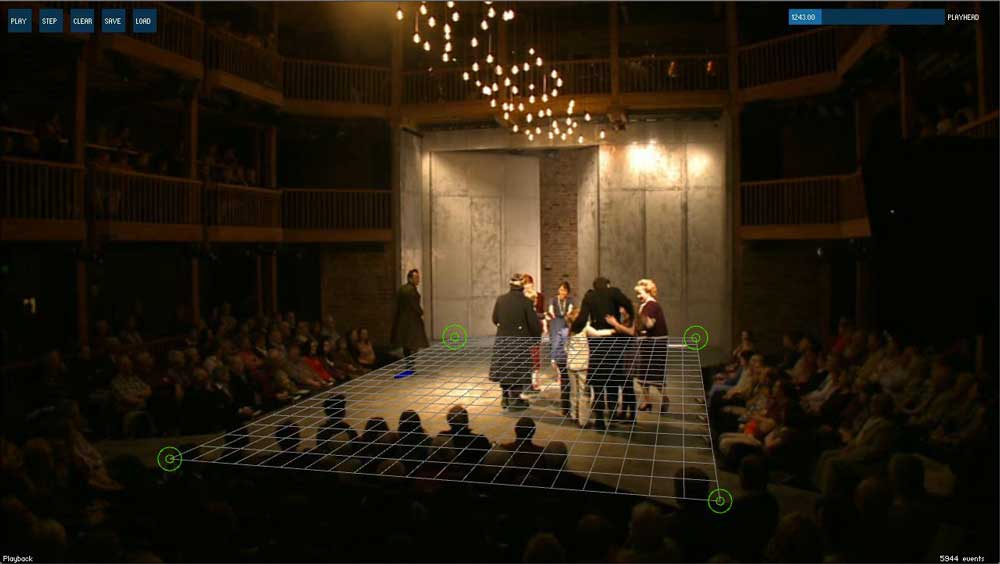Our revels now are ended. These our actors,
As I foretold you, were all spirits and
Are melted into air, into thin air:
— The Tempest, Act IV, Scene i
Spirits Melted Into Air takes individual scenes or speeches - in this case, from the 2012 Royal Shakespeare Company productions of Richard III and The Comedy of Errors - and produces data-visualisations of actors' motion during them.
Produced by Tom Armitage for the Royal Shakespeare Company, the work is in parts a technology prototype, data visualisation, and artwork.
It explores stripping the text away from dramatic performance: removing the playwright, and leaving only the production elements - the actor, the director, and everyone else who influences a performance. The project seeks to highlight the work that the Royal Shakespeare Company does in bringing the written texts of Shakespeare's plays to life.
Capturing the data
The data was captured from performance footage in a custom-built Processing application. The movements of the actors to be captured were individually traced from video using a mouse cursor.
The footage was all taken from a perspective viewpoint. To counter that, a quadrilateral with the same aspect ratio as the stage in each video was mapped to the four corners of the stage, using the Keystone library. This meant that whilst mouse-movements were traced in perspective, it would be possible to calculate where they were in a rectangular space, and obtain an approximation of a top-down viewpoint.
The data was stored as a list of co-ordinates, one per frame of video (at 30fps). These co-ordinates could then be used to produce subsequent visualisations and artworks based upon the actors' motion.
Visualising the data in print
The first visualisations produced were posters depicting the scenes in question. Another Processing sketch converted the captured lists of co-ordinates to SVG paths, which could then be manipulated in Illustrator and InDesign.
They display the paths taken by the actor(s), annotated with appropriate lines from the text, anchoring speech to motion. The format of the posters hints at other representations of motion in print - dance notation, or football play-by-play diagrams.
Click the images for larger galleries of the posters.
Visualising the data in wood
Print isn't the only medium we can visualise this data in. The plots of movement data were also translated laser-cut birch plywood.
These wooden shapes are more abstract than the printed visualisations; more aesthetically pleasing than utilitarian. Engraved arrows hint at the directions of movement the actors take.
For The Comedy of Errors, each actor was cut as an individual piece of wood to the same scale, allowing the two paths to be overlaid, one atop the other.
Click the images for larger galleries of the lasercuts.
What's next
Spirits Melted Into Air was a short technology exploration project. Even from this brief starting point, it's still clear that there are several interesting avenues to explore in future experiments with tracking actors.
Automating data capture would be a huge leap forward: it would allow for more faithful reporting of actors' positions, and also speed up the process of moving from performance to visualisation. This could be achieved perhaps through electronic positioning systems, or from depth-camera point clouds.
Tracking many more actors would be interesting from an aesthetic standpoint: understanding how large crowds interact. This would be particularly interesting with choreographed sequences, dance or otherwise.
Tracking actors across many performances is perhaps, for me, the most interesting idea. By layering data from an entire run of shows - and perhaps even from rehearsals - the evolution of a performance can be visualised. This also helps to emphasise the impact particular audiences have on shows, and how actors respond differently over time.
Interactive visualisations would almost certainly have some value, especially in the example of exploring an actor's motion across many performances. I stayed away from losing time in building over-complex software, given the tight scope of this project, and instead focused on attractive, physical manifestations. But now the grain of the data is clearer, interactive visualisations would be particularly useful for exploring much larger datasets.
Exploring other materials for physical representation is another clear avenue. With clearer, less tangled paths, smaller representations would become more elegant; producing traces in metal, perhaps as jewellry, was an early idea, and it still has an aesthetic charm. Were I to visualise larger numbers of actors, I'd probably explore cutting paths in transparent acrylic - so that even when stacked, they can be seen through one another.
Credits & Thanks
Spirits Melted Into Air by Tom Armitage (email) is one of three Caper commissions for myShakespeare. myShakespeare is produced in 2012 by The Royal Shakespeare Company on the occasion of the World Shakespeare Festival, which the company is producing on behalf of the London Organising Committee of the Olympic Games and Paralympic Games Ltd.
Printing by Quattro Design and Print.
Lasercutting by Cut Laser Cut.
Press/Contact
For more information, and for high-resolution photographs suitable for print, do get in touch.












